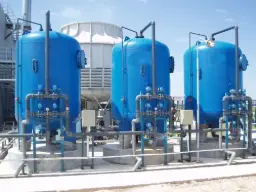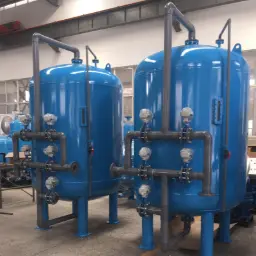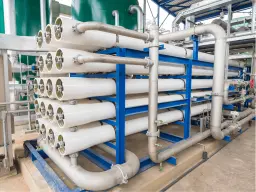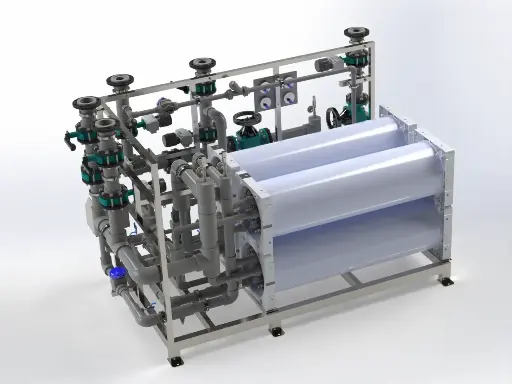Steam Generation for Sterile Processes
Steam Generation for Sterile Processes sits at the convergence of utility engineering and pharmaceutical-grade hygiene, and it demands a rigorously controlled water treatment backbone. In any facility that sterilises equipment, vials, or biological products with clean steam, the purity of the water feeding the boiler cascades directly into product quality, patient safety, and regulatory compliance. Operators recognise that even trace levels of hardness minerals or organic contaminants can nucleate deposits, disrupt heat transfer, and seed microbial growth along steam distribution lines. Over time, such seemingly minor impurities accumulate at control valves, condensate traps, and steriliser chambers, forcing outages and jeopardising batch integrity.
A modern clean-steam generator therefore functions as a hybrid between a high-pressure boiler and a water purification skid. While thermal energy drives evaporation, the true differentiator is the feed-water preparation train that strips silica, total organic carbon, bacteria, and endotoxins to parts-per-billion levels. When operators map the mass balance of an autoclave centre, they find that 95 % of downtime root causes trace back to upstream water anomalies rather than the steam generator shell itself. Because of this empirical lesson, design teams devote significant capital to pretreatment, polishing, and real-time analytics, understanding that dollars invested before the boiler return dividends in sustained uptime. The overarching objective is to deliver steam that meets or exceeds pharmacopoeial grades such as USP Purified Water or HTM-2031 clean-steam specifications. Achieving those grades means integrating multi-barrier purification, employing stainless-steel 316L piping with orbital welds, and validating every sanitary clamp and diaphragm valve. Digitalisation further elevates reliability; cloud-connected conductivity probes, TOC analysers, and turbidity meters flag excursions before they propagate downstream. Meanwhile, sustainability pressures motivate recovery of high-grade condensate as boiler feed, slashing both chemical consumption and energy input. In sum, when professionals discuss Steam Generation for Sterile Processes, they are really outlining a tightly choreographed symphony of water treatment, mechanical design, automation, and quality management that must perform flawlessly shift after shift.
Water Treatment Systems Used
Ensuring that the feed water for Steam Generation for Sterile Processes meets ultra-pure benchmarks requires more than a single technology; it calls for a layered defence where each stage removes a specific class of contaminants while protecting the subsequent stage from overload. Engineers therefore begin by analysing raw water chemistry, scaling tendencies, and microbial counts, then select complementary treatment modules sized for peak steam demand plus redundancy margins. They consider buffer tanks, recirculation loops, and hygienic pumps with low-shear impellers, examining how each element contributes to hydraulic stability and microbial control. The sizing philosophy favours moderate flux rates and conservative velocity limits in stainless-steel piping, recognising that aggressive flow rates shorten membrane life and increase shear-induced particle release. Construction materials receive equal scrutiny; any elastomer exposed to hot, oxygen-starved water must withstand both thermal cycling and sanitising chemicals.
In parallel with mechanical design, engineers craft a controls architecture that unites all water treatment systems under a single SCADA or DCS umbrella. Advanced PID loops modulate valve positions and inverter-driven pumps to hold pressure set points with ±0.05 bar resolution, while soft sensors estimate ion leakage between on-line calibrations. Data packets stream to manufacturing execution systems, allowing batch records to capture conductivity and TOC trends in real time. Asset performance management dashboards apply machine-learning algorithms to flag deviation patterns that precede element fouling or resin exhaustion, enabling predictive maintenance instead of reactive intervention. This holistic perspective treats water treatment not as a bolt-on utility but as a fully integrated, digitally monitored organ of the sterile-manufacturing ecosystem. Against this backdrop, the following primary systems combine to deliver water quality that qualifies for steam-in-place (SIP) and autoclave sterilisation duties:
Related Products for Steam Generation Processes

Multimedia Filtration
A stratified bed of quartz, garnet, and anthracite removes suspended solids >5 µm, protecting downstream membranes from sediment abrasion.

Activated Carbon Filter
Microporous carbon granules adsorb chlorine, chloramines, and low-molecular-weight organics, preventing oxidative damage to RO membranes and lowering feed TOC.

Reverse Osmosis
A spiral-wound polyamide membrane rejects 95-99 % of dissolved ions, silica, and endotoxins, delivering permeate with <30 µS cm-¹ conductivity and <0.5 mg L-¹ TOC.

Electrodeiyonization (EDI)
Continuous-regeneration ion-exchange stacks polish RO permeate to resistivity values >10 MΩ cm, eliminating the need for chemical regeneration and reducing operational downtime.
Key Water-Quality Parameters Monitored
Producers of sterile products appreciate that meeting regulatory steam specifications is not a binary pass-fail test but an ongoing tug-of-war between contaminant ingress and system control. Consequently, water-quality monitoring for Steam Generation for Sterile Processes is designed around continuous, high-resolution analytics rather than sporadic grab sampling. Instrument engineers install conductivity cells both before and after each purification stage, generating differential readings that quantify membrane or resin performance in real time. Turbidity monitors warn of pretreatment breakthrough, prompting backwash cycles before particulate overload occurs. Online TOC analysers use UV-persulfate oxidation combined with NDIR detection to track organic load to sub-ppb levels, an essential metric because oxidisable carbon can decompose during steam generation and introduce endotoxin-like fragments.
Operators calibrate these instruments against traceable standards and implement alarms tied to quality-by-design (QbD) risk assessments. For instance, a conductivity spike in the RO permeate loop may trigger an automatic divert-to-drain sequence, avoiding contamination of the EDI feed and preserving final water quality. In parallel, supervisory software plots rolling averages and process capability indices, helping quality engineers demonstrate Cp k >1.33 for critical parameters during regulatory audits. The following table summarises the principal water-quality parameters, the typical ranges targeted for steam generation, and the primary control methods used to maintain them within specification.
| Parameter | Typical Range | Control Method |
|---|---|---|
| Conductivity | <1 µS cm-¹ (pre-boiler) | RO plus EDI, feedback control on blend valve |
| Total Organic Carbon (TOC) | <0.5 mg L-¹ | GAC adsorption, UV-C photo-oxidation |
| Turbidity | <0.2 NTU | Multimedia filtration with periodic backwash |
| Silica | <0.1 mg L-¹ | RO removal, EDI polishing |
| Microbial Count | <10 CFU 100 mL-¹ | UV-C disinfection, hot-water sanitisation |
Design & Implementation Considerations
Bringing a Steam Generation for Sterile Processes train from concept to commissioning begins with a thorough demand analysis that aligns water-treatment capacity with autoclave cycle times, SIP circuits, and utility redundancy requirements. Engineers start by calculating peak steam flow during worst-case simultaneous sterilisation events, then add a contingency factor of 10-15 % to account for future expansions and fouling margins. The resulting feed-water volume informs membrane surface area, resin bed depth, and buffer tank sizing. At this preliminary stage, process engineers collaborate closely with piping designers to draft a hygienic P&ID that minimises dead legs and maintains turbulent flow at velocities between 1.0 and 1.5 m s-¹, discouraging biofilm attachment.
Material selection quickly rises to the top of the decision matrix. Austenitic stainless steel 316L with a surface finish ≤0.6 µm Ra is the default for wetted components, although duplex grades may be justified where chloride stress-cracking risk is high. Elastomers are specified as EPDM or PTFE validated for FDA and EU 1935/2004 contact, and welds undergo orbital fusion followed by 100 % boroscope inspection. Instrument enclosures meet at least IP 65, while transmitters exposed to wash-down areas carry IP 69K ratings. Automation engineering incorporates redundant PLCs running validated firmware, dual power supplies, and fail-safe valve positions that revert to drain in the event of signal loss. International standards frame every design choice: ISO 22000 governs the food-safety management of ancillary utility systems in biotech plants, WHO TRS 970 Annex 2 provides guidance on pharmaceutical water, and NSF/ANSI 5 sets construction criteria for commercial water equipment. In the United States, the FDA’s 21 CFR 211.67 demands documented preventive maintenance, while Europe’s EN 285 defines saturated-steam parameters for sterilisation. Compliance does not end with construction; commissioning agents develop IQ, OQ, and PQ protocols that confirm the system performs within acceptance criteria under dynamic load. Digital validation platforms now shorten this timeline by generating test scripts directly from design data and storing traceable electronic signatures.
Energy efficiency and sustainability layer additional design vectors. Variable-speed blowers allow RO concentrate recirculation to adapt to conductivity set-points, saving kilowatt-hours without sacrificing rejection. Heat exchangers capture boiler blowdown energy to pre-warm RO feed, while condensate return lines reclaim up to 20 % of latent heat. Greenfield projects may even integrate membrane-based degasification to strip dissolved CO₂ without caustic chemicals, reducing carbonate scaling and lowering neutralisation costs. All these features converge to deliver a water-treatment train that not only meets sterility demands but also aligns with corporate ESG targets.
Operation & Maintenance
Once commissioned, the long-term success of a Steam Generation for Sterile Processes system hinges on disciplined operation and maintenance routines that preserve design intent. Plant managers publish detailed SOPs covering start-up checks, valve stroke verification, and sanitisation sequences, ensuring that operators know exactly how to transition between production and maintenance modes. On a daily basis, technicians log key performance indicators such as RO differential pressure, EDI cell voltage, and UV-C intensity, comparing real-time values against historical trends to spot drift before alarms trigger. Weekly actions often include checking sight glasses for condensate clarity, verifying calibrations of inline temperature sensors, and sampling for microbial plating.
Preventive maintenance integrates clean-in-place (CIP) cycles tailored to each unit’s fouling profile. For RO membranes, a low-pH citric-acid wash dissolves scale, followed by a high-pH surfactant wash that disperses biofilm. Membrane replacement typically occurs every three to five years, yet predictive analytics based on normalised permeability can extend life when feed quality remains stable. EDI stacks require periodic electrode polarity reversals and once-annual gasket replacement. UV lamps operate for about 9 000 hours before output drops below 80 % and they fail the intensity interlock. An effective spare-parts strategy therefore maintains at least one full set of critical consumables onsite: a complete RO membrane vessel, a set of UV-C bulbs, and the most failure-prone valve actuators. Meanwhile, competence management ensures operators hold confined-space entry certification, understand lock-out-tag-out procedures, and can navigate PLC HMI screens to interrogate alarm logs. Continuous training combined with augmented-reality troubleshooting guides keeps downtime low and audit readiness high.
Challenges & Solutions
Even a well-engineered installation confronts a spectrum of operational challenges that threaten water purity and steam quality. Scaling remains the perennial nemesis where calcium, magnesium, or silica exceed solubility limits, forming insulating layers on boiler tubes and membranes. Bio-fouling lurks in low-flow dead legs and ambient-temperature tanks, compromising microbial specifications and accelerating corrosion. Regulatory hurdles also intensify as GMP auditors focus on data integrity, cybersecurity, and lifecycle validation.
- Scaling on Membranes and Boiler Tubes – Mitigation includes antiscalant dosing optimised via LSI calculations, periodic acid CIP, and online silica monitoring linked to an automated bypass.
- Bio-fouling in Distribution Loops – Countermeasures involve maintaining turbulent flow >1 m s-¹, employing periodic hot-water sanitisation at 80 °C for 30 minutes, and installing ozone generators for low-chemical sanitisation.
- Regulatory Data-Integrity Gaps – Plants deploy 21 CFR Part 11-compliant historians with audit trails, redundant time servers, and role-based access to safeguard electronic batch records and satisfy inspectorates.
Advantages & Disadvantages
While Steam Generation for Sterile Processes provides unparalleled assurance of microbial sterility, it is not without drawbacks, and decision makers benefit from a balanced perspective. Capital expenditure is substantial because multiple purification stages, high-grade materials, and validated instrumentation drive up initial cost. Operating expenditure also rises due to energy intensity, particularly when steam is vented during start-up or condensate is not fully reclaimed. Nevertheless, the process delivers direct quality benefits by providing on-demand sterile utility, eliminating the need for chemical sterilants, and enabling faster changeovers between product lines. Sustainability advantages emerge through condensate return, waste-heat recovery, and the elimination of single-use sterilisation consumables. Yet the high degree of automation introduces cybersecurity attack surfaces that must be managed with network segmentation and regular patching. The following table summarises the key pros and cons to aid strategic decision-making.
| Pros | Cons |
|---|---|
| Provides validated microbial sterility without chemical residues | High capital and operating costs |
| Supports real-time, clean-steam sterilisation of equipment and piping | Requires high-purity feed water and complex pretreatment |
| Eliminates disposal of chemical sterilants, enhancing sustainability | Energy intensive, particularly during frequent start-stop cycles |
| Facilitates rapid batch changeovers in multiproduct facilities | Demands skilled operators and rigorous maintenance |
| Produces condensate that can be recycled, lowering utility demand | Expands the plant’s cybersecurity attack surface through digitalisation |
Frequently Asked Questions
A deeper understanding of Steam Generation for Sterile Processes often arises from practical questions posed by operating personnel and quality teams. Addressing these queries up front streamlines project alignment and accelerates validation.
Q: What feed-water quality is recommended before the boiler to meet USP clean-steam requirements?
A: A conductivity below 1 µS cm-¹ and TOC under 0.5 mg L-¹, typically achieved with RO followed by EDI, provide a robust starting point that satisfies pharmacopoeial clean-steam specifications.
Q: How often should RO membranes be replaced?
A: With proper CIP and stable feed chemistry, spiral-wound membranes last three to five years; predictive models based on normalised flow and salt rejection guide the exact replacement schedule.
Q: Can clean-steam condensate be reused as boiler feed?
A: Yes, provided condensate conductivity and TOC remain within limits; condensate recovery can slash fresh-water intake by up to 20 % and improve overall energy efficiency.
Q: Which international standards govern design and validation?
A: Key references include WHO TRS 970 Annex 2 for pharmaceutical water, EN 285 for sterilisation steam, ISO 22000 for food safety management, and the FDA’s 21 CFR 211 for cGMP requirements.
Q: What are common alarm thresholds for TOC?
A: Plants often set a warning at 0.3 mg L-¹ and a trip at 0.5 mg L-¹, triggering automatic divert-to-drain and initiating an investigation per GMP deviation procedures.
Q: How is microbial control maintained in ambient loops during downtime?
A: Options include continuous low-dose ozone, periodic thermal sanitisation, or maintaining a minimum recirculation velocity of 1 m s-¹ to discourage biofilm formation.
Q: What cybersecurity measures protect the control system?
A: Best practices involve layer-3 network segmentation, read-only historian interfaces, multi-factor authentication, and quarterly patch management aligned with ISA/IEC 62443 guidelines.